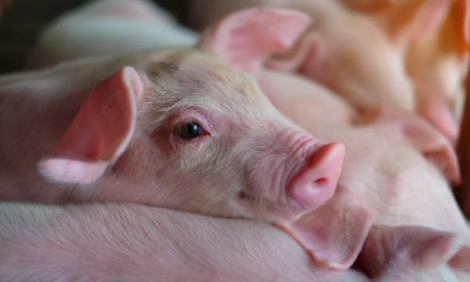



On-Farm Feed Milling: Gearing up for Compliance in the 21st Century
By Eduardo Beltranena IAZ PhD, published by Prairie Swine Centre - The Canadian Food Inspection Agency (CFIA) published in the Canada Gazette (Part 1; 2000 February 05) the proposed new regulations for the mixing of medicated feeds. These minimum compliance standards must be met by manufactures of medicated feeds in order to be licensed and sell medicated products.
Commercial feed mills should comply within a year of the regulations been approved. Farms using drug premixes (with a Drug Identification Number or DIN) should comply by the end of the second year and farms using medicated premixes and supplements should comply by the end of the third year. CFIA’s good intentions are applauded; however, these regulations will be coming out too late. The Canadian Pork Council (CPC) Pork Quality Assurance program has recommended for some time that producers keep drug inventories. The three-year phase-in period further suggests that there is no urgency. Emphasis seems to be on medicated feeds, but thanks to the forward thinking of CPC and provincial pork boards, our sights have been on pork safety not just on drug residues for some time. CFIA wants the new regulations comprised under the Health of Animals Act, apparently to facilitate enforcement, instead of improving the obsolete Feed Act.
Get over the fears that non-compliance in three years may trigger on you if CFIA had the budget to police them!! There won’t be cost recovery fees for licenses or inspections. Instead, focus on the benefits of extending quality assurance to the on-farm feed mill. I assure you, you will be producing safer, wholesome pork if you grasp not all but at least some of the principles in Hazard Analysis and Critical Control Points (HACCP), and its prerequisites Good Manufacturing Practices (GMPs). This essay introduces these principles and their practical application to on-farm feed milling.
Good Manufacturing Practices
GMPs are practices that reduce the number of critical control manufacturing points needing attention. Therefore, these are considered prerequisites to HACCP. GMPs can become extremely detailed, but the following are a good start for your on-farm feed mill:
1. SOPs, checklists & forms:
Writing Standard Operating Procedures (SOPs) is the first and most time consuming step. SOPs can be extremely long and detailed, but few would use them. First, write an outline and then add just enough detail to reflect what you normally do. From outlines, you can prepare checklists, which evolve into forms. Forms are critical records that attest what was done, when and by whom. You just cannot do quality assurance without completed forms!
2. Receiving:
At a farm feed mill you receive bulk grains and meals, bagged ingredients and fats (i.e., oil, grease). Describe how each type of commodity is received to minimize unsafe contamination. How do you identify on arrival, checked for damage, sample, date, etc.?
3. Storage & distribution equipment:
Bulk bins, warehouse containers and tanks should be properly identified and clean. Conveyors, augers, legs, head distributors, etc. should be free of build-ups. Use of ingredients should preferably be first-in, first-out.
4. Weighing & mixing:
All scales used should be standardized routinely using reference weights and cleaned at least weekly. Calibration should be performed based on a schedule by a qualified contractor. The mixer may require slightly different timing to optimize the mixing of different type diets. Give paramount importance to sequencing of feeds and flushing to minimize drug contamination onto subsequent non-medicated feed batches.
5. Maintenance:
Prepare a schedule of preventive maintenance, including the feed truck, and a log to attest that this is being performed.
6. Premises:
Proper design and construction of the feed mill is important. Describe the keeping of the building, warehouse and grounds (snow removal, etc.). Describe the waste disposal and its operation.
7. Sanitation & pest control:
Prepare a schedule detailing what should be cleaned and when. Complete a log to prove that you are doing it. Draw a sketch where mice traps are located and record trapping rates.
8. Recalls:
Can you deny that, from time to time, mixing errors occur? Pre-assess the risk to humans and animals and have a notification plan in place. Setup procedures to help you trace mixed product and pre-determine ways to deal with it.
9. Training:
New staff requires a quick GMPs orientation. Recurring training should be provided involving those that might be called upon when someone is absent or sick.
10. Manufacturing documentation:
A good record keeping system is not only helpful for quality assurance purposes but also essential for tracking ordering, receiving, inventory, shipping, accounting, etc.
Hazard Analysis and Critical Control Points
Unlike GMPs that involve recurring procedures, HACCP is a one-time analysis with minor re-evaluation from time to time. In preparing a HACCP plan for your on-farm feed mill, take the following guiding steps:
1. Identify potential hazards:
The first step is to identify potential hazards to humans and animals. These include biological (bacteria, mould, etc.), physical (glass, metals, etc.) and chemical (drugs, pesticides, etc.) hazards, but these can be minor compared to major bu-bu’s untrained operators can stage.
2. Evaluate each process step:
Consider potential hazards that exist or may develop at each step in the manufacturing process. For example, biological, chemical and physical hazards are more likely at receiving. In contrast, operator error is the predominant hazard at mixing or feed delivery to farm bins. Establish critical control points, where the loss of control may evolve into a health risk.
3. Targets & tolerances:
It is impossible to get grains entirely free of micro-organisms, chemical residues, stones, etc. What's tolerable? You need to do testing, but how much does it cost to test ingredients? What level of medication contamination is considered acceptable after two equipment flushes? How much does it cost to test drug swipes?
4. Monitoring:
If testing raw ingredients is cost prohibiting, have coffee with Bob and Mike to emphasize why is important that they wash the fertilizer residue off their trucks before they deliver grain to you! Screen suppliers, set delivery specifications, ask for certifications, emphasize that you are producing food not just raising hogs! How often should we test mixed feeds and how to interpret the lab results?
5. Corrective actions:
If you sporadically lose control, plan how would you deal with non-complying product. Document the cause of the problem and what you did about it.
6. Verifying:
Evaluate your plan from time to time and if changes have occurred, improve procedures. Invite outsiders to criticize your HACCP plan and catch the obvious that you missed. Have them over several times before you request a CFIA inspector(s) pursuing licensing.
7. Use your plan!
Don't file your HACCP plan in a cabinet! Have it printed big and laminated. Post it on the wall where you can write on it and constantly evaluate and ponder how to mix safer feed for your piggies and pork consumers!
Conclusion
Again, focus on the benefits of extending quality assurance to the on-farm feed mill. Instead of worrying about regulations, try adopting the principles describe here. Then, talk to your packers to show them that you have the safest pork and are well deserving of premiums.
Source - Prairie Swine Centre - January 2004








